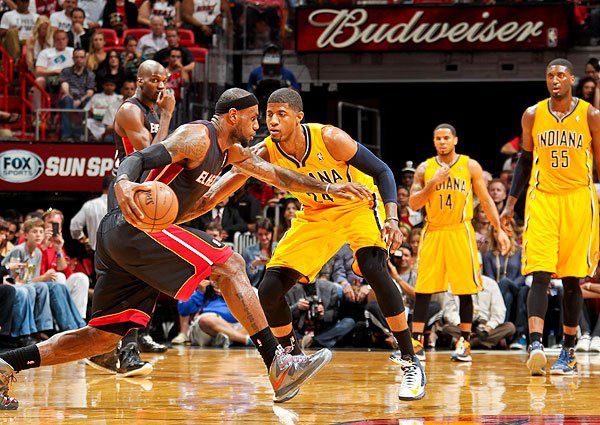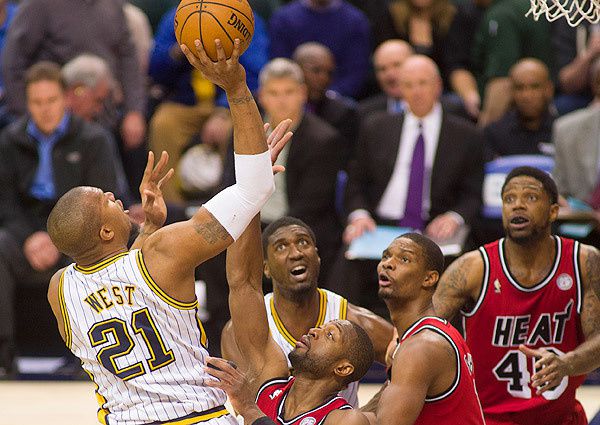
After marching through two rounds of the postseason, the Heat will face their greatest challenge yet in the hard-defending, power-posting Pacers. Indiana won two of three regular-season meetings, but even that isn’t enough to make the Heat anything less than a decisive favorite in the Eastern Conference finals. In fact, the greatest point of debate lies in guessing the length of the series rather than its outcome; there is a wide consensus that Indiana is in over its head, equipped to put up a fight but not to win.
Unfortunately for the Pacers, that seems a fair characterization. But with games yet to be played, Indiana’s hope still springs. Coach Frank Vogel’s team is good enough to give the Heat trouble, and as a result hold some chance — however slim — of upsetting the defending champions. It certainly won’t be easy, but the following details a few of the strategic elements that could help the Pacers shock Miami and the basketball world at large.
NBA playoffs: Miami Heat vs. Indiana Pacers preview
• Execute their defense to perfection. In this matter, the Pacers have little choice. They absolutely must be at the top of their collective defensive game if they’re to keep up in this series — a task that promises to be far more difficult than it was against the Knicks in the second round. New York was all too willing to settle for the inefficient shots that Indiana’s defensive philosophy encourages, but Miami will pursue better looks. Ball movement and dribble penetration will force the Pacers to defend consecutive actions from players who consistently project as a threat to score, and in that Miami will conduct multiple tests of Indiana’s defensive focus with every trip down the floor. Indiana is one of the few teams that can legitimately slow Miami’s roll, but it will take peak defensive operation from the Pacers to do more than win a few games.
That effort starts with placing a high priority on LeBron James and Miami’s shooters, with a concession of sorts for Dwyane Wade. The Pacers won’t cede open looks to Wade, but they will — and should — do all they can to funnel the ball in his direction and away from James. As good as Wade is, he’s a far less taxing cover for the Pacers on the whole and slightly less dangerous both because of his pull-up tendencies (which tend to be augmented by effective defenses) and slightly lesser finishing ability. Wade will be a challenge in his own right if a knee injury doesn’t plague him. But the Pacers will stay at home on Miami’s perimeter shooters just as they did with New York’s, match Paul George up with James to stall him as effectively as possible and live with the results of a Wade-centric offense if they can.

Of course, Indiana won’t be able to force the ball out of James’ hands consistently enough to deny him and the Heat their primary offensive functions. He’ll still attack from the top of the floor, post up when possible and compromise Indiana with pick-and-roll play. That last element is a pressing concern. As good as Indiana is in covering pick-and-roll sequences in general, the Pacers’ default strategy of having Roy Hibbert hang back to defend the paint may not be so effective against James. Although the patch of mid-range space that Hibbert provides opponents may compel James to toss up a few runners, it also affords him room to gain a full head of steam — providing the means to better attack Hibbert and conceivably get the Pacers’ defensive anchor into foul trouble. Vogel has only instructed Hibbert to step up into a higher, more aggressive pick-and-roll defense in very select cases this season (the reason: Hibbert just isn’t quick enough to step up beyond the three-point line to hedge against a ball handler and still recover back to his man in time), but he may need to consider that option if James’ drives to the hoop become problematic.
• Rebound tirelessly, and use Miami’s lack of size against it. This one’s simple enough. Indiana ranked fifth among Heat opponents in both offensive rebounding rate and defensive rebounding rate this season, and it used those advantages to maximize its strengths on both ends of the court en route to a 2-1 edge in the season series. Miami isn’t a bad defensive-rebounding team by way of personnel, but it is often so stretched and scrambled by the end of a possession that opponents can fight their way to extra opportunities on the glass. It’s in this regard that Hibbert, David West, Tyler Hansbrough and Ian Mahinmi must generate value. They’ll have a chance to earn extra scoring chances if they’re willing to put in the effort and box out intelligently, and should pursue those ends aggressively if the Pacers’ guards provide the floor balance necessary to defend against a potential Heat fast break.

• Be ready to attack fronting defenders. Miami victimized Indiana in the 2012 postseason with an exceedingly simple defensive tactic: Rather than leave an undersized defender at the mercy of Hibbert or West, Heat coach Erik Spoelstra had his quick, intuitive big men front the post, denying the entry pass. That stratagem was effective enough for the Heat to survive the absence of Chris Bosh and a chronic size deficit, in part because it preyed on the Pacers’ more general offensive weaknesses. Indiana can be a formidable team when allowed to initiate its offense uninterrupted, but even the slightest hiccup on the perimeter can cause the team’s already deliberate post-ups to lag. The Pacers walk the ball up the court, the big men fight for position, the guards get slightly tentative in throwing an entry pass and all of a sudden the 24-second shot clock has dwindled to 10, leaving time for but a single make-or-break action.
West and Hibbert are big and skilled enough to make the most out of many of those rushed opportunities, but overall, Indiana’s plodding execution (and lack of perimeter shot creators) makes for an intrinsic, hard-wired flaw. It’s who the Pacers are, for better or worse, and it’s unlikely that they’ll be able to totally revamp their offense to the point where these issues disappear.
Miami will again attempt to deny Indiana access to its most advantageous matchups, leveraging team-wide speed and flexibility to compensate for a lack of conventional size. That may well give the Pacers trouble at times, but with a few go-to maneuvers, they should be able to beat the Heat’s fronts somewhat reliably. Picking up the tempo would go a long way, as simply getting the ball up the floor more quickly will give Indiana the advantage in terms of establishing position. As effective as fronting the post can be, it essentially requires an entire set defense in order to function. If West or Hibbert can get down to the block and quickly create the angle necessary to receive a pass, they’ll be able to initiate offense against more familiar coverage.
Beyond that, there are a handful of little things that Indiana can do to make itself less vulnerable to defensive fronting. A bit of misdirection can set up a wide-open shooter on the weak side of the floor, an area in which the defense naturally tilts away from in order to safeguard against the lob. Some off-ball screens and timely cuts opposite the post should prove incredibly effective, provided the Pacers can find the right timing to employ them.
It’s also important that Indiana doesn’t allow itself to get bogged down. George Hill is particularly guilty of holding the ball as he waits for the entry angle to become available, but against Miami it’s crucial for him and the other Indiana guards to move on with other options if that angle never surfaces. The opportunities will be there for the Pacers if they know what they’re looking for and come to the series with an understanding of how and where to attack a defensive front that leaves Miami a bit exposed.
• Place a priority on drawing fouls as a means to manipulate matchups. Indiana scored reasonably well against Miami in the regular season by drawing fouls more frequently than all but four Heat opponents — many of which came through well-purposed ball movement and pure effort. West’s flexibility in receiving the ball at different areas of the floor allowed him to post up more easily than Hibbert, and from there he was able to strong-arm his way into a few foul calls by attacking the Heat’s defenders individually. If he can accomplish that much against either Shane Battier or James, he could help the Pacers reap serious dividends beyond mere free-throw attempts. Hansbrough was also able to get to the free-throw line with impressive frequency (5.3 attempts in 13.7 minutes per game against Miami), largely by counterattacking on offensive rebounds and cutting opposite the Heat’s defensive rotations. If he can continue that level of activity in this series, he could, even in limited minutes, prove significant in dictating Miami’s lineups by way of creating foul trouble.
Battier’s exits typically correspond with the substitution of Ray Allen, whose quality as a shooter is less relevant in this case than his liabilities as a defender. Indiana can deal with Allen’s perimeter marksmanship, as it held him to 18.8 percent shooting from the field in three games this season by way of typically mindful defense on his three-point tries. The real gains for the Pacers, however, would come on defense, where Allen is a far less versatile option for Miami and a player who could potentially be exploited off the dribble. Lance Stephenson and George both have the tools to attack Allen if the situation arises, and earning early fouls on players like Battier may well force Spoelstra’s hand.
A similar principle applies in regard to Bosh. While Battier and Allen present similar offensive threats, Bosh and his likely replacement, Udonis Haslem, do not. When Bosh has been on the floor this season, the Heat score 111.6 points per 100 possessions compared with only 90.8 points per 100 possessions with him on the bench. Bosh’s shooting puts enough pressure on Hibbert to open up driving lanes and shooting opportunities across the floor, and if the Pacers can take away that impact by putting Bosh in foul trouble, then they would see the challenge of guarding the Heat slim substantially.
Statistical support for this post provided by NBA.com.
/image%2F1426505%2F20150121%2Fob_c65e86_gfr.png)

/idata%2F4924922%2F8e-de-Finales-Eurocup%2Frotator.jpg)
/idata%2F4924922%2FLAST-32-EUROCUP%2Fjordi-bertomeu-meets-greek-media.jpg)
/idata%2F4924922%2FEUROCUP-2014-SUITE2%2Fmvp-t13-rudy-fernandez.jpg)
/idata%2F4924922%2FEUROCUP-2014-SUITE2%2Fmarcelinho-huertas.jpg)
/image%2F1426505%2F20240428%2Fob_8b789d_1000076256.jpg)
/image%2F1426505%2F20240428%2Fob_758f4f_1000076195.jpg)
/image%2F1426505%2F20240428%2Fob_55a703_1000076192.jpg)
/image%2F1426505%2F20240428%2Fob_d1dc43_1000076177.jpg)